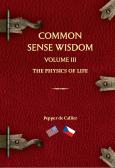Food for Thought
One of the many joys of my job is that I am continually doing research about leadership and human nature. In the course of that research, I occasionally find a real gem—something that almost magically coalesces a thought, an insight, or a concept in a way that is crisp, concise, clear and memorable.
A former colleague of mine at Spencer Stuart, James Citrin, recommended a book in a recent blog of his. The book, titled Wherever You Go, There You Are, is written by the bestselling author, Jon Kabat-Zinn, who is the Founder and Director of the Stress Reduction Clinic at University of Massachusetts Medical Center. Kabat-Zinn’s work, in large part, deals with something called “mindfulness”, or awareness of the present moment. Now, if this sounds a bit New-Agey, as it did to me, let me assure you that it is not. After many years of a skeptical quest for understanding and my own research, there is a wonderful ring of truth to much of what Kabat-Zinn offers.
In our rush to find answers to big-picture questions, we sometimes forget to consider the “less-big” elements that, when joined, clustered and connected, create a much more fully-textured, deeper, and potentially profound, understanding of the big picture.
Here’s an excerpt from Wherever You Go, There You Are titled, “Eachness and Suchness” that I think sums up the point quite nicely and gets even better with repeated readings.
“Wholeness experienced first-hand cannot be tyrannical, for it is infinite in its discovery and finds itself mirrored and embedded in each particular, like the Hindu goddess Indra’s net, a symbol of the universe, which has jewels at all the vertices, each one capturing the reflections of the entire net and so containing the whole. Some would have us worship, uniformly, at the altar of oneness, using the idea of unity rather than an ongoing encounter with it to steamroller-like, flatten out all differences. But it is in the unique qualities of this and that, their particular individuality and properties—in their eachness and suchness, if you will—that all poetry and art, science and life, wonder, grace, and richness reside.
All faces resemble each other, yet how easily we see in each uniqueness, individuality, an identity. How deeply we value these differences. The ocean is a whole, but it has countless waves, every one different from all the others; it has currents, each unique, ever-changing; the bottom is a landscape all its own, different everywhere; similarly the shoreline. The atmosphere is whole, but its currents have unique signatures, even though they are just wind. Life on earth is a whole, yet it expresses itself in unique time-bound bodies, microscopic or visible, plant or animal, extinct or living. So there can be no one place to be. There can be no one way to be, no one way to practice, no one way to learn, no one way to love, no one way to grow or to heal, no one way to live, no one way to feel, no one thing to know or be known. The particulars count.”
What a wonderfully elegant explanation of “The Whole” and how very important the “particulars” are in life.




